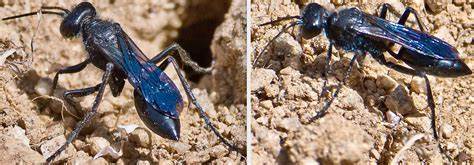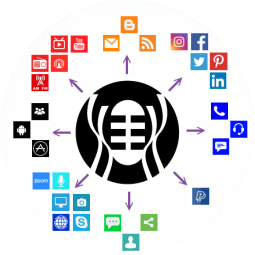Sustainably Yours, With Love
How we can help sustain and maintain our primal eco system of plant life by growing Pollinator plants
The late afternoon sun spilled over my garden as I knelt among rows of tender seedlings, their green tips piercing the earth like tiny promises. As I diligently walked the rows checking their progress, a flicker of movement caught my eye. Near the edge of a bed, a large, ink-black insect—wasp-like, —worked intently at a tiny hole in the dirt. Its legs churned, tossing out puffs of dust and dirt. Deeper and deeper it burrowed and then finally it disappeared into the earth’s embrace, leaving only a small hole in the soil.
I froze, captivated. There was something sacred in this quiet labor, this small creature carving out a home in my garden’s heart. I smiled as I tried to film it, and for a moment, the world was just us: the insect, unaware of my gaze, and me, a grateful witness to its unassuming magic. I smiled, realizing it had escaped my clumsy feet and my instinct to flinch. This was peace—shared, unspoken, and alive.
That evening, I drove to my family's house and we began talking of flower varieties that we could start now, April 23rd here in Boise where I live at 2700 elevation to be ready for a July wedding in McCall Idaho (5200 elevation), 100 miles north of me where it is not frost free until June. I was envisioning a weedy hillside transformed into a vibrant wildflower meadow. The bride, my niece, dreamed of a ceremony full of color and the scents of wild flowers and a fresh picked wild flower bouquet.
As we sketched out the site, I steered the conversation toward pollinators. My family, avid hummingbird enthusiasts, hang feeders each summer, delighting in the territorial battles of who rules the feeder and the shimmering color of vibrating wings and iridescent throats . But I wanted more for this meadow—a living tapestry of flowers and plants to beckon bees, butterflies, wasps, and even bats. “Imagine,” I said, my voice bright with possibility, “a garden that doesn’t just feed hummingbirds but sustains every pollinator, knitting the ecosystem together.” Their eyes lit up, and soon we were swapping ideas: lupine for butterflies, milk weed for monarchs, bee balm for bumblebees, evening primrose for moths under starlight.
That night, as I lay in bed, the image of the black insect, who I identified as The Great black Wasp (sphex pensylvanicus) returned. They live in the ground and are an important pollinator wherever they show up. It's quiet determination mirrored my own growing resolve. Pollinators, I realized, are the unsung architects of our world—tiny, tireless, weaving life from flower to flower, season to season. My deep dive into their importance had just begun, but already I felt tethered to something larger: a commitment to nurture the land, not just for a wedding, but for the countless creatures who call it home. With every seed I’d plant, I’d be writing a love letter to the earth—sustainably, and with all my heart.
That night, I pored over books on pollinators, struck by their quiet power. A single bumble bee, I learned, can pollinate thousands of flowers in a day, knitting together the meadow’s web of life. Without them, the berries we pick in McCall’s forests or the alfalfa fields down in Boise would vanish. My garden, I realized, was more than a hobby, it can become a sanctuary for these most important creatures . As I have discussed in our podcast, Down and Dirty with Idaho Bo and Vivacious Vic, that I used to have bee hives. I am well aware of what they do and how friendly they become when you walk among them everyday. It is truly magic and the enhanced abundant harvest from our apple trees when they were here to pollinate for many years made an incredible difference.
Anyone, anywhere, can join this mission of supporting and sustaining the web of life through feeding the pollinators and creating a peaceful and colorful world at the same time . Whether you have a balcony pot, a suburban yard, or acres of land, a few thoughtfully placed plants can host pollinators. Choose natives with staggered bloom times— let the dandelions bloom, prairie smoke for spring bees, beeplant for summer hummingbirds, smooth aster for fall butterflies—to feed them all season. It can be a fun project for the whole family and especially children, who will delight in watching bumble bees burrow into blooms or monarchs sip from milkweed they planted. With every seed, we write a love letter to the earth—sustainably, and with all our hearts.
Here you can scan a list of beautiful, bountiful and common flowers to choose from. You can look up many more online for your specific area. These listed are very common plants for zone 5 and 6.
Let the dandelions bloom in your early spring grass, yard or field. They are the first flowers that bees go to immediately after coming out of the hive HUNGRy.
Milkweed for Monarchs - will seed and come back every year.
Lavender- perennial bees love lavender
Honeysuckle- a vine perennial
Yarrow- native to Idaho and many western states
Larkspur- an annual that seeds heartilly and will come back every year
Goldenrod- native
Coneflower or Echinachea- perennial
Coreopsis- perennial and seeds itself and spreads
Black eyed Susan- perennial and also seeds itself
Cosmos- annual and seeds itself if mulched over in the winter
Poppies- all kinds are pollinators
Salvia- perennial
Canna Lilies- Annual bulbs in zone 6 and below- must be dug up and wintered over- Hummingbirds dream
Bee Balm or Monarda- perennial









